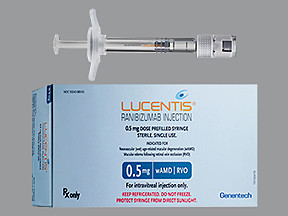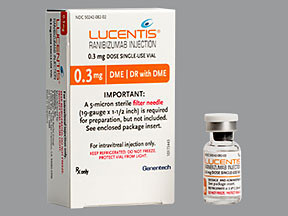RANIBIZUMAB - INTRAOCULAR
PHONETIC PRONUNCIATION: (ra-ni-BIZ-oo-mab)
COMMON BRAND NAME(S): Lucentis
GENERIC NAME(S): ranibizumab
Uses
USES: This medication is used to treat certain serious eye conditions (such as age-related macular degeneration, macular edema, diabetic retinopathy). It is used to help prevent decreased vision and blindness. Ranibizumab works by slowing the growth of abnormal new blood vessels in the eye and decreasing leakage from these blood vessels.
How to use RANIBIZUMAB - INTRAOCULAR
HOW TO USE: Read the Patient Information Leaflet if available from your pharmacist before you start receiving ranibizumab and each time you get a refill. If you have any questions, ask your doctor or pharmacist. This medication is given by injection into the affected eye(s) by a health care professional. The affected eye is numbed before each injection. Your eye will be monitored before the injection. After the injection, you will remain in the doctor's office for a while, and your eye will continue to be monitored. The dosage is based on your medical condition and response to treatment. This medication is given as directed by your doctor, usually once a month for most conditions. When treating age-related macular degeneration, if you are not able to have monthly injections after your first few doses, getting injections once every 2 or 3 months may be an option, although not as effective as monthly injections. Consult your doctor for more details. Use this medication regularly to get the most benefit from it. Tell your doctor if your condition does not improve or if it worsens.
Side Effects
Precautions
Interactions
Overdose
Images
Reviews
Faq for RANIBIZUMAB - INTRAOCULAR
Ranibizumab is a drug that is injected into the eye to treat various eye conditions such as wet age-related macular degeneration (AMD), macular edema, diabetic retinopathy, and macular edema following retinal vein occlusion.
Ranibizumab is an anti-vascular endothelial growth factor (VEGF) drug. It works by binding to and inhibiting VEGF, a protein that can cause abnormal blood vessel growth in the eye. By blocking VEGF, ranibizumab helps to reduce the growth and leakage of abnormal blood vessels, thereby improving vision.
The recommended dosing regimen for ranibizumab depends on the specific eye condition being treated. For most conditions, the initial treatment involves monthly injections for a certain period, followed by less frequent maintenance injections as determined by your doctor. However, your doctor will tailor the treatment plan to your individual needs.
The most common side effects of ranibizumab include eye pain, floaters, increased intraocular pressure, conjunctival hemorrhage, and blurred vision. Serious side effects such as infection or detachment of the retina are rare but possible. It is important to report any concerning symptoms to your doctor promptly.
The onset of ranibizumab's effects can vary depending on the individual and the eye condition being treated. Some patients may start noticing improvements in their vision within a few days or weeks after starting treatment, while for others it may take longer. Your doctor can provide more specific information based on your situation.
After receiving a ranibizumab injection, your eyes might be sensitive and your vision may be temporarily blurred. It is recommended to avoid driving until your vision has fully recovered, which usually occurs within a day or two after the injection. It is best to arrange for someone else to drive you home after the procedure.
Disclaimer
IMPORTANT: HOW TO USE THIS INFORMATION: This is a summary and does NOT have all possible information about this product. This information does not assure that this product is safe, effective, or appropriate for you. This information is not individual medical advice and does not substitute for the advice of your health care professional. Always ask your health care professional for complete information about this product and your specific health needs.



No Reviews Yet